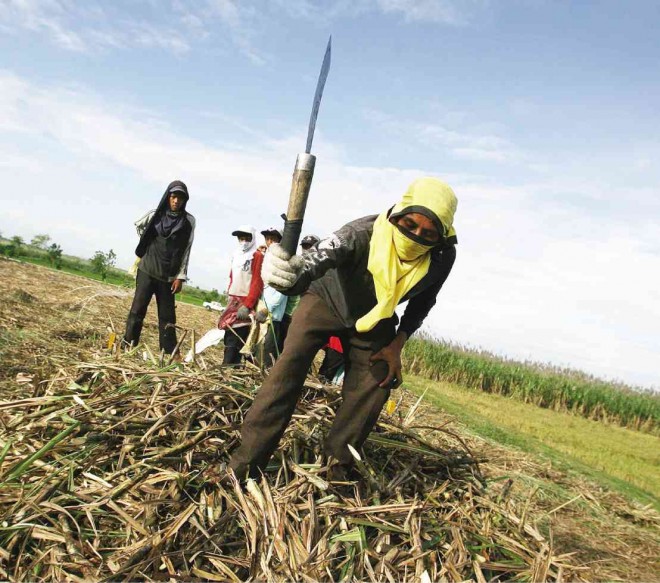No crop other than sugar in Luisita

A WORKER chops newly harvested sugarcane in a farm in Concepcion town, Tarlac province, that is part of the more than 6,000-hectare Hacienda Luisita, an estate owned by the family of President Aquino, which the government allegedly wants to remain dedicated to sugar production. LYN RILLON
CITY OF SAN FERNANDO—The government wants to keep Hacienda Luisita a sugar-producing area to sustain the operations of a mill owned by President Benigno Aquino’s family, according to a leader of farm workers who received plots of land in the agricultural estate that had been placed under the land reform program.
The government, in compliance with a Supreme Court ruling, has started distributing at least 4,100 hectares of the estate long held by the Cojuangcos, Mr. Aquino’s relatives, to farm workers.
Roger Amurao, secretary general of Farmworkers Agrarian Reform Movement (FARM), said the Department of Agrarian Reform (DAR) was promoting the continued use for sugarcane of the pieces of land given to farm workers because it wanted to sustain the operations of Central Azucarera de Tarlac, a sugar mill also owned by the Cojuangcos.
“Growing sugarcane does not ensure that we who received lots, through the landmark ruling of the Supreme Court, would have food crops to eat,” Amurao told the Inquirer by phone.
“As a cash crop, sugarcane brings little income,” he added.
Article continues after this advertisementIn Baguio City on Thursday, Agrarian Reform Secretary Virgilio de los Reyes discussed sugar in relation to the anticipated economic and social integration moves of the Association of Southeast Asian Nations (Asean) next year.
Article continues after this advertisement“We have no choice but to lower our production cost so we don’t have to worry about the entry of Asean agricultural products,” he said at a news briefing. “The Philippines has over a hundred million people, which means we have a very large internal market,” he said.
“Take sugar, for example. We are a net importer of sugar. People are worried about the sugar of Thailand … but if we are able to lower the production cost of our sugar, which we are doing already in Tarlac and Negros Occidental—with agrarian reform beneficiaries, not haciendas—we will still be competitive with Thailand in the case of sugar,” he said.
“We will be mechanizing our sugar the way we plant and the way we harvest,” he said.
In a final ruling in 2012, the Supreme Court directed the DAR to distribute the bulk of the land to workers who held stocks in Hacienda Luisita Inc.
This was after the high court upheld the decision of the Presidential Agrarian Reform Council to cancel the stocks distribution program, which was the first mode of the Comprehensive Agrarian Reform Program in Hacienda Luisita in 1989.
But the DAR is not helping beneficiaries shift to planting rice and vegetables, Amurao said, adding that many lots in the estate are still covered by arriendo through which sugar planters rent the lands of agrarian reform beneficiaries for P7,000 to P10,000 a year.
For the first time, they tied them to three-year contracts until 2016, FARM and Alyansa ng mga Manggagawang Bukid sa Asyenda Luisita leaders said in separate interviews in May.
In a statement, Amurao said the “push for sugarcane block farming does not take into account the hunger situation of farm workers. It completely disregards the reality that patches of rice lands have been developed inside Hacienda Luisita through the sheer hard work of farm workers in line with their desire to solve hunger through food security in their respective households.”
He said 6,600 square meters were given to each farm worker through raffle draws, displacing those who already cultivated the lands with crops other than sugarcane ahead of the 2012 Supreme Court order.
Rosalina Bistoyong, agrarian reform undersecretary for support services, said “great opportunities” awaited the Luisita beneficiaries because the agency “has unveiled various options each of them could avail themselves of, foremost among which is the tested sugar block farming concept.”
She said sugar block farming program “works best for the interest of the farmers as it envisions to get them to work together for the greater good of all.” With a report from Vincent Cabreza, Inquirer Northern Luzon